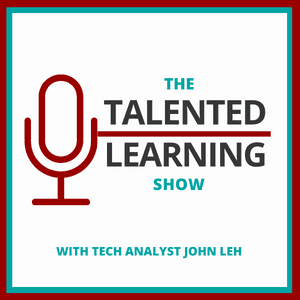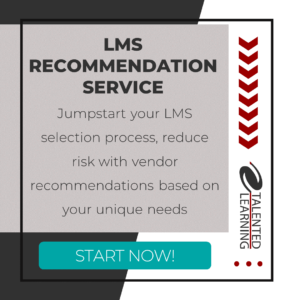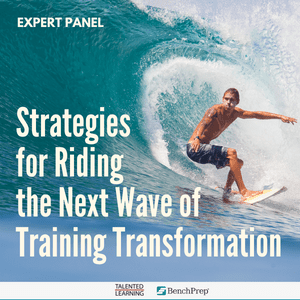
Podcast: Play in new window | Download
Subscribe: Apple Podcasts | Spotify | Amazon Music | Android | iHeartRadio | Blubrry | Email | RSS
EPISODE 59: TRAINING INFRASTRUCTURE

John Peebles, CEO, Administrate
Do you want to expand your organization’s training reach, but your ecosystem isn’t robust or agile enough to scale with ever-changing business needs? Then don’t miss today’s podcast.
That’s because I’m interviewing John Peebles, CEO at Administrate. After joining the company as COO over a decade ago, John has been on a mission to distinguish Administrate as a world-class training operations platform for blue-chip corporations. And his persistence is paying off with a portfolio of Fortune 1000 clients.
Even if you’re not actively looking for a training infrastructure solution, this is worth a listen to understand factors that are shaping modern enterprise learning.
TRAINING INFRASTRUCTURE – KEY TAKEAWAYS
- In this era of online learning and digital transformation, you might think ILT training infrastructure issues are mostly behind us. But that’s not the case for many organizations that deliver learning at scale.
- A “platform” approach to ILT training infrastructure is a strategic advantage, because it dramatically improves operational efficiency and responsiveness. It also provides flexibility to grow and evolve in a fluid business environment.
- Artificial intelligence and automation are redefining every corner of the learning systems space. This includes innovative tools that are adding value at the training infrastructure level.
TRAINING INFRASTRUCTURE – Q&A HIGHLIGHTS
Welcome to the show, John. Let’s start with some background about your company and we can go from there…
Sure. We’re headquartered here in Scotland, but most of our business is done in North America. And obviously, my accent is American.
My route to Administrate really started when I was CTO at a pharmacy transaction processing software company in Florida. We continually needed to onboard a whole bunch of people — employees, customers and partners. And that training fell under me. So I had to figure out how our rapidly growing company could train a massive number of people internally and at hundreds of hospitals across the U.S.
Finding a solution to this huge training challenge remained an unsolved problem. And it hurt our growth. So when I left that company, the question of how to scale a business by scaling learning was still top-of-mind for me.
That’s when I happened across a tiny tool focused on something similar. It was designed to help training organizations grow their operations without locking up business processes in spreadsheets and paper and the like.
Ahh…
And so I joined them. That’s because I really felt acutely the problem of not only getting training operations straightened out and implemented and scalable, but also having to justify the budget to my CEO. Where was this money going that didn’t seem to affect growth? We all knew it really was making an impact. But actually demonstrating it was really difficult.
So there are two sides of the coin. How do you get training operations running well? And how do you demonstrate ROI? That’s the problem we’re trying to solve here at Administrate.
Why is this still a problem? Aren’t these operational issues solved by online learning or e-learning?
Great question. We think e-learning is a really useful tool. But during the past 20 years, our industry has over-indexed on it.
Still, so much training actually requires people to be hands-on with equipment, or it focuses on specialized skills that people have to be taught. And these skills are unique to a specific company.
Think of it this way: It doesn’t matter if you’ve been a BMW plant worker your entire career. If Mercedes hires you, you need to relearn everything.
Do you want more information and analysis on the top 40 learning systems in the world? Buy our 2023 Corporate Learning Systems Market Update report – now available through the 2nd half of this year at a 50% discount!
Now, we’ve known for years that behavior modification is one of the most efficient ways to get folks to really internalize learning. And classroom training tends to be the most effective way to modify a learner’s behavior. So it’s not surprising that, depending on what you read, between 60% and 80% of all training in corporate America is still conducted in a classroom — virtual or in-person.
That’s the reality. And we believe that whole area has been underserved by the learning technology landscape over the last couple of decades.
Interesting. So, when you say learning at scale, what does that mean to you?
We tend to target organizations with minimum of 1000 employees. There are obviously exceptions. For example, some of our customers are fast-growing early-stage companies.
But we can help when an organization has hundreds of instructors or more, and thousands (or tens of thousands) of courses a year, and tens of thousands of learners, if not more.
Very sophisticated multinational organizations are running training all over the globe, all the time. They could have dozens or even hundreds of people on their team. And they’re trying to standardize their operations.
Tell us more. What ILT training infrastructure challenges are they facing?
When we think of challenges in delivering classroom training, we think about questions like these:
- Where will the training session be located? Do you have the right room?
- Is the right equipment in the right room? Does it need to be moved? Or staged into place? Does it need to be cleaned beforehand? Or checked after? Or calibrated?
- Do we have the right instructors? Are their qualifications current?
- Do materials need to be sent? Are books or e-learning built into the learning experience? Is pre-work or post-work required? How will all that be assembled and ready to go for students?
- How do we communicate all the details to students? How do we send out emails to 1000s of people at different stages of their learning journey so they know they need to go to the right class at the right time, and prepare themselves to participate?
- And by the way, let’s make sure we don’t screw up their meal along the way. Does anyone have an allergy or dietary requirements?
All of these things impact the perception of training quality and the learner experience, which we’re all trying to maximize. Plus, all of these things can directly impact the efficacy of the training itself.
Right…
Getting this done is hard enough for just one event. But then, try rolling that out and running it hundreds and hundreds of times globally, in different time zones, different languages, and so forth. It quickly becomes a nightmare.
So, because most platforms aren’t solving this problem, training organizations have developed home-grown spreadsheets to manage it all. Maybe some more sophisticated folks have put together rudimentary software. But it’s a huge problem. And it’s compounded by the fact that training teams often don’t even own all of these resources.
For example, they may not exclusively control meeting rooms. It just devolves and devolves and devolves. So we’ve got some really frustrated folks out there doing a really good job, but they aren’t set up to run training operations successfully.
Do you want more information and analysis on the top 40 learning systems in the world? Buy our 2023 Corporate Learning Systems Market Update report – now available through the 2nd half of this year at a 50% discount!
How does a training infrastructure platform help?
Well, as a software company, we understand how important customer training is in the software industry. And software companies often acquire other software companies. In fact, one of our large customers has been averaging about two acquisitions a week. Imaging trying to train your sales force on the latest, greatest tool you’re bringing into your massive intergalactic product portfolio.
How do you roll that out? How do you make sure the people who need to be trained are in a program that will onboard them quickly and effectively? That is very difficult to do. And how do you repeat that new product training several times a week, in addition to all the training you’ve already been planning for the last six months, anyway?
This is the kind of fluid environment we see with a lot of our customers.
I think many organizations don’t realize how much money they’re pouring down that hole…
You know what I think is super tragic? We’ve yet to encounter a customer or a partner that doesn’t understand how to demonstrate ROI, or how to show that training is moving the business needle.
People know what they need to measure. We’ve never found a shortage of great ideas from customers. They may want to show that training helps increase new sales or improves the customer experience. But they can’t, because they just don’t have the training infrastructure in place.
Yep…
History teaches us the same lesson. Think about Napoleon trying to invade Russia. He was one of the most brilliant generals of all time. He had one of the best armies ever assembled. His plan was perfect. And he knew all the necessary logistics for a successful campaign.
But there was a missing ingredient. Railroads to Russia hadn’t been built and the telegraph hadn’t been invented.
So without that infrastructure he needed, the effort was doomed to fail.
We view today’s learning landscape the same way. There are so many talented, amazing people working really hard. They’re just hampered by a complete lack of infrastructure.
Good analogy! So let’s shift gears and talk a bit about an innovative tool you’ve developed using AI to do some heavy logistics lifting. Could you tell us about that?…
…FOR COMPLETE ANSWERS TO THIS AND MORE QUESTIONS ABOUT CHANNEL TRAINING SYSTEMS, LISTEN TO THE FULL 30-MINUTE PODCAST!
Need Help Finding the Best Training Infrastructure Platform for Your Organization?
Fill out the form below to request a complimentary consultation call with John Leh:





